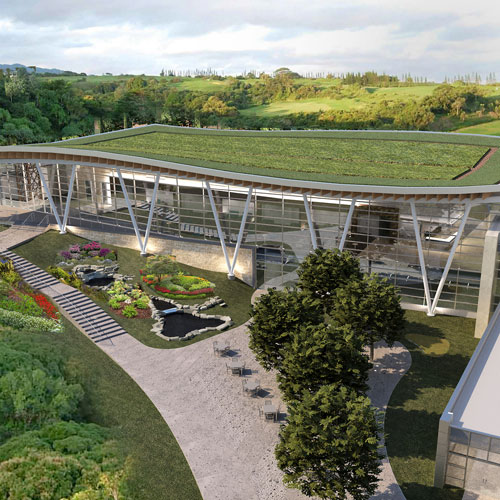
How has the One Sony Initiative played out from the perspective of facilities management?
We’re taking a hard look at how to downsize our footprint—not so much in total space but in the location of the space—to be a little more cohesive and homogeneous among all the Sony companies. As we think about workplace solutions, the direction has been to put all the Sony groups closer together to utilize each facility for a shared opportunity.
So there’s not new construction happening so much as a reconfiguring of existing space?
Right. It’s about knowing that you can configure each space in different ways for different groups, which means they don’t each have to be in a separate building. Sometimes it’s as simple as different-size workstations, whether 6’ x 6’, 6’ x 8’, just tables and chairs—or hammocks and Red Bull for some, but you can all coexist.
Sony’s Shimmering
LEED Gold Headquarters
Sony Electronics of North America moved into a new 11-story, 450,000-square-foot corporate headquarters in the San Diego hills in summer 2009, and Craig W. Logan, vice president of facilities, procurement, and business solutions, has been tailoring it to the One Sony Initiative since 2012. Floors 6–11 have ocean views (complete with fire pits and couches on balconies), the dining facility is on the top floor, and there is an employee health club on top of the parking structure. The lobby serves as a showcase of Sony products, with PlayStation games and Sony movies playing on Sony entertainment systems, and Sony Music selections play on a sound system wired throughout the facility.
“This is a place where people can feel at home and relax, instead of a sterile office building,” Logan says. “Let’s face it: we spend more time at work than we do at home, so it’s important to be comfortable and enjoy it.”
But, in addition to showcasing Sony’s commitment to social sustainability in the workplace, the headquarters is a demonstration of the company’s efforts toward environmental sustainability. There are photovoltaic cells on the parking structure, condensation from the air chillers is recycled in ornamental water features, and energy-efficient plumbing and electrical fixtures reduce water and power consumption by 47 and 23 percent, respectively.
Hammocks and Red Bull?
In Sony’s Entertainment Network divisions, where they can create and run the gaming system for PlayStation, the engineers and software programmers have a floor with lots of open space and just a few offices for management. They may need to be here 36 straight hours. Who knows? That’s how they want to work, so they may be sleeping in hammocks and drinking Red Bull, but that’s what drives their culture and results. That’s how they attract and retain talent. Be opened-minded and flexible—and have fun.
That’s certainly not your conventional office space.
Yes, culturally, if you step onto their floor, you see something a little different. The sales and marketing folks all want low walls, and the accountants all want high walls because they have to concentrate.
So the members of each Sony division get to choose what works for them, and you help make that happen in a way that’s cohesive for the whole company?
We don’t have to knock down a bunch of walls and rebuild things to make the areas more compatible just because the businesses may be different. Sony Pictures, Sony Music, PlayStation, Sony Electronics—office space is office space. It’s about the proper utilization of the space. It’s about tenant improvements and how we fabricate the façade for the respective business cultures. It’s the inside skin of the rooms that we’re configuring to their personality and needs, not so much the architectural structure of the building.
What’s on the walls for each of the cultures you’re referring to?
PlayStation has action figures on their walls, Sony Pictures has movie themes and movie stars on the walls, and Sony Electronics—well, we just have basic office space. I guess we’re the most boring. [Laughs] Sometimes, it’s just the color schemes and whole-wall photos that need to be changed.
Is the idea that by encouraging diversity of expression, you achieve unity within the larger company culture?
Yes, if everyone can configure the space to their likings or to their kind of a standard, it’s easier to work together … instead of being a dysfunctional family. When you’re kids, you can all live under one roof with your parents, and then the minute you become adults, you can’t because everybody has their own way of doing things. But, as we get older again, we learn to get along. So, that’s been the goal: to break down those barriers within Sony. We want to remove the silos and partner better with our brothers and sisters.
How is this philosophy rippling out into Sony’s retail facilities?
We’re closing our retail stores in North America and replacing them with key business partnerships. For example, we have a Sony Retail Experience that we’ve opened up in 400-plus Best Buys. It’s a little store within the store, but it showcases the best of the best in our products.
That sounds like a good complement to the emphasis on online sales these days.

Not every retailer needs to occupy their own unique brick-and-mortar location. If you build it inside where people are already going anyway, like a Best Buy, you’re increasing the traffic. It’s part of the same philosophy: reduce our footprint but not lose the exposure, the impressions on potential customers. Instead, we’re trying to change the equation in terms of the cost per impression. It’s a value-added approach that allows us to put more [product] through the portal.


